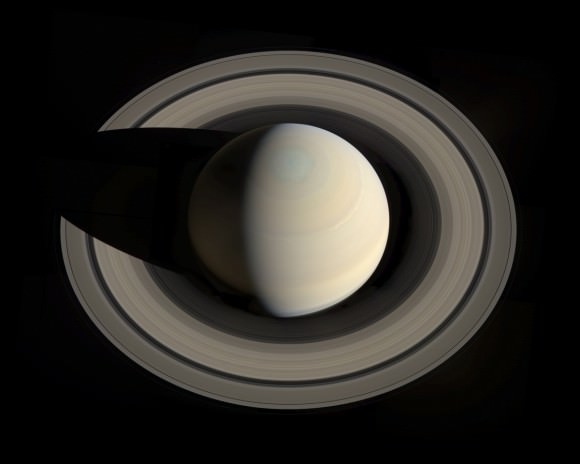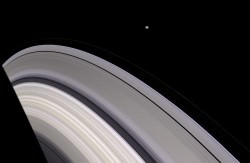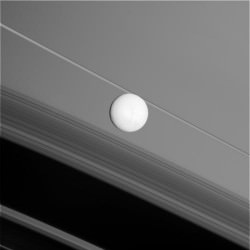Dr. Kevin Grazier was a planetary scientist with the Cassini mission for over 15 years, studying Saturn and its icy rings. He was also the science advisor for Battlestar Galactica, Eureka and the movie Gravity.
Mike Brown is a professor of planetary astronomy at Caltech. He’s best known as the man who killed Pluto, thanks to his team’s discovery of Eris and other Kuiper Belt Objects.
We recently asked them about many things – here’s what they shared with us about the rings of Saturn.
Saturn’s majestic, iconic rings define the planet, but where did they come from?
Kevin Grazier: “Saturn’s rings, good question. And the answer is different depending on which ring we’re discussing.”
That’s Dr. Kevin Grazier, a planetary scientist who worked on NASA’s Cassini mission or over 15 years, studying Saturn’s rings extensively.
Mike Brown: “Saturn’s rings – the strange things about Saturn’s rings is that they shouldn’t be there, really, in the sense that they don’t last for very long. So, if they are just left over from when Saturn was formed, they’d be gone by now. They would slowly work their way into Saturn and burn up and be gone. And yet they’re there. So they are either relatively new or somehow continuously regenerated. ‘Continuously regenerated’ seems strange and ‘relatively new’ seems also kind of strange. Something broke up – a large moon broke up, or a comet broke up – something had to have happened relatively recently. And by relatively recently, that means hundreds of millions of years ago for someone like me.”
And that’s Mike Brown, professor of planetary geology at Caltech, who studies many of the icy objects in the Solar System.

Saturn’s rings start just 7,000 km above the surface of the planet, and extend out to an altitude of 80,000 km. But they’re gossamer thin, just 10 km across at some points.
We’ve known about Saturn’s rings since 1610, when Galileo was the first person to turn a telescope on them. The resolution was primitive, and he thought he saw “handles” attached to Saturn, or perhaps what were big moons on either side.
In 1659, using a better telescope, the Dutch astronomer Christiaan Huygens figured out that these “handles” were actually rings. And finally in the 1670s, the Italian astronomer Giovanni Cassini was able to resolve the rings in more detail, even observed the biggest gap in the rings.
The Cassini mission, named after Giovanni, has been with Saturn for almost a decade, allowing us to view the rings in incredible detail. Determining the origin and evolution of Saturn’s rings has been one of its objectives.

So far, the argument continues:
Kevin Grazier: “There’s an age-old debate about whether the rings are old or new. And that goes back and forth – it’s been going back and forth for ages and it still goes back and forth. Are they old, or have they been there a long period of time? Are they new? I don’t know what to think, to be quite honest. I’m not being wishy-washy, I just don’t know what to think anymore.”
Evidence from NASA’s Voyager spacecraft indicated that the material in Saturn’s rings was young. Perhaps a comet shattered one of Saturn’s moons within the last few hundred million years, creating the rings we see today. If that was the case case, what incredible luck that we’re here to see the rings in their current form.
But when Cassini arrived, it showed evidence that Saturn’s rings are being refreshed, which could explain why they appear so young. Perhaps they are ancient after all.
Kevin Grazier: “If Saturn’s rings are old, a moon could have gotten too close to Saturn and been pulled apart by tidal stresses. There could have been a collision of moons. It could have been a pass by a nearby object, since in the early days of planetary formation, there were many objects zooming past Saturn. Saturn probably had a halo of material in it’s early days that was loosely bound to the moon.”

There is one ring that we know for certain is being refreshed…
Kevin Grazier: “The E-Ring, certainly a new ring, because the E-Ring consists of roughly micron-sized ice particles. And micron-sized ice particles don’t last in space. They sputter and sublimate – they go away in very short time periods, and we knew that. And so when we went to Saturn with Cassini, we knew to look for a source of materiel because we knew that the individual components of the E-Ring don’t last, so it has to be replenished. So the E-Ring stands alone from the established system, and the E-Ring is absolutely new.”
In 2005, scientist discovered that Saturn’s E-Ring is being constantly replenished by the moon Enceladus. Cryovolcanoes spew water ice into space from a series of fissures at its south pole.
So where did Saturn’s rings come from? We don’t know. Are the new or old? We don’t know. It just another great mystery of the Solar System.
You can follow Kevin Grazier and Mike Brown at their Google+ pages!


Frankly, I think this article is a mess, but even the scientists interviewed really seemed clueless and all over the map:
“Saturn’s majestic, iconic rings define the planet, but where did they come from?
Kevin Grazier: ‘Saturn’s rings, good question. And the answer is different depending on which ring we’re discussing.’
What a weak, obfuscating dodge. Is he implying that the rings of Saturn by and large are the result of a hodge-podge of unrelated events? Preposterous.
Kevin Grazier: “If Saturn’s rings are old, a moon could have gotten too close to Saturn and been pulled apart by tidal stresses.
Its incredible to me that not once in this article is it ever even mentioned that the rings are almost entirely *water ice* in chunks ranging all the way up to the size of a house.
“But when Cassini arrived, it showed evidence that Saturn’s rings are being refreshed, which could explain why they appear so young. Perhaps they are ancient after all.”
The above sentence makes no sense.
Is the article asking *us* where the rings came from? All of the scientist interviewed admitted they don’t have a clue.
“But when Cassini arrived, it showed evidence that Saturn’s rings are being refreshed, which could explain why they appear so young. Perhaps they are ancient after all.”
OK, I get the point being made now. At any rate, Europa — full of water; Enceladus — full of water. Saturn’s rings — full of water. But I thought the outer solar system was where water naturally formed, so what’s the mystery.